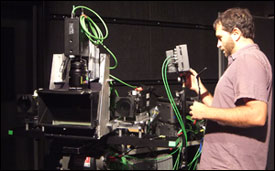
4-Camera System Aims for Glasses-Free 3-D
BERLIN, Sept. 28, 2011 — A newly developed four-camera assistance system that reduces the calibration time from days to minutes makes it possible to watch 3-D TV without glasses.
For glasses-free 3-D TV, autostereoscopic displays are needed, which are coated with special optical foils. They create two different images for the left and the right eye, which is the basic principle of 3-D vision. To allow different viewing positions — for instance, when the viewer moves his head — these displays use five to 10 views of an image. In the future, this number will be considerably higher.
Conventional stereoproductions have only two views. However, the captured images must be converted before transmission, for which purpose depth information is extracted from them. To reliably determine the depth information, it is recommended to use more than two cameras.

A research scientist calibrates the four-camera assistance systems. (Image: KUK Filmproduktion)
Now, researchers at Fraunhofer Institute for Telecommunications Heinrich Hertz Institute have collaborated with 12 partners in the MUSCADE project to use four cameras for 3-D TV without glasses.
The stereoproduction is already extremely intricate and expensive and takes days to calibrate four cameras to each other, the scientists say. The collaboration’s new four-camera assistance system could reduce this time frame to about 30 to 60 minutes.
“The development is based on our STAN assistance system, which has already proved its value in conventional stereoproductions,” said Frederik Zilly of Fraunhofer HHI. “But with four cameras, calibration is much more complicated.”
The complication arises because all positions and angles of the camera must be set exactly the same so that the optical axes are parallel, all lenses have the same focal length, and all focal points are on a common stereo basis. To achieve this, the scientists developed a feature detector to recognize identical objects in the image on all four cameras. Using their position, the assistance system can then calibrate the individual cameras to each other.
The researchers pointed out that even after calibration, small inaccuracies remain because lenses with fixed focal lengths are used, which in most cases are subject to small fluctuations. Such residual faults can be corrected only electronically using digital zoom.
This last correction stage is carried out by the new system in real time, making even live transmissions possible.
The HHI researchers are currently working on an efficient video encoding system for compressing huge volumes of data that arise when four cameras are used so that the content can be transmitted on the existing broadcasting infrastructure. They presented their first prototype at the IBC trade show in Amsterdam.
For more information, visit: www.hhi.fraunhofer.de
Published: September 2011